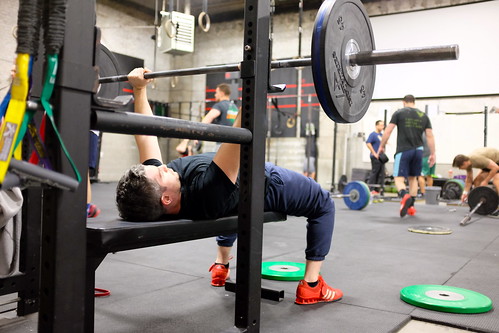Why Your Gym Should Program Rest Days
 Monday, March 16, 2015 at 12:00AM
Monday, March 16, 2015 at 12:00AM Any effective strength and conditioning programming has to account for work-to-rest ratio in order to manage stress and allow the body to adapt to training. CrossFit often teaches the three-on/one-off template, as well as the five-on/two-off template. At CrossFit South Brooklyn, way back in 2008, we started using a three-on/one-off, two-on/one-off template, which has worked extremely well for us. This schedule allows our athletes to train at high intensities throughout the week while not overextending themselves, and it provides our gym with a consistent programming template and weekly schedule.
We all know rest is important, but an obstacle to rest for many affiliates is accounting for programmed rest days while remaining open seven days per week (which is a practical and financial necessity for most gyms). The two most common solutions we’ve seen affiliates come up with include either offering seven days per week of novel programming, or running alternative, low-intensity programming on particular days—perhaps a skills class, Active Recovery, or just open gym time. We’ve also seen gyms simply close on Saturdays or Sundays, which creates a mandatory rest day for their populations. At CFSBK, our membership options and three-on/one-off, two-n/one-off template allow athletes to take up to five CrossFit group classes per week. We additionally provide various skill classes (yoga, Pilates, etc.) and open gym time. This allows us to offer seven days per week of attendance options without compromising our programming, and this precludes overzealous members from coming in every single day and training themselves into the ground.
 Where Rest Days Fit Within CFSBK’s Programming
Where Rest Days Fit Within CFSBK’s Programming
In my opinion, gyms that offer unlimited memberships and daily novel workouts have serious potential for developing bad training habits and popularizing the errant idea that more is better. As we discussed in “Effective Programming Strategies for CrossFit Affiliates," CFSBK programs rotating eight-week training cycles, with Tuesday and Friday as scheduled rest days. By programming in this way, we’re able to plot out a consistent lifting schedule for our members and avoid the training interference, redundancy, and excessive volume associated with performing or programming intense workouts seven days per week.
So what happens on a programmed rest day? On Tuesdays and Fridays, group classes run split programming, meaning one coach runs the previous day’s workout while another coach simultaneously runs the next day’s. Running split programming on those days requires foresight and planning, and we make sure to account for available space and equipment when writing out the programming for that week.
The feasibility of this option for your affiliate will depend both on your staffing constraints and available real estate. We currently run upwards of 20+ person classes in our 4,800 square-foot facility using two coaches. Let’s walk through an example of a typical programming spread and see how we would run it.
Monday:
Standardized Warm-Up
Bench Press 5x3 or 5-5-5-5-5
“Annie”
50-40-30-20-10 Reps, For Time:
Double-Unders
Sit-Ups
 Tuesday
Tuesday
Rest Day
Athletes who come in will have the option of performing Monday or Wednesdays programming at any group class.
Wednesday:
Standardized Warm-Ups
Deadlift 3x3 or 1x5
3 Rounds, For Time:
Row 400m
20 Wall Ball Shots
10 Chest-to-Bar Kipping Pull-Ups
After doing some movement prep and our Question of the Day, we would have our athletes start their standardized warm-ups. Then the coaches gather everyone around the white board to discuss the two training options, and split the class up based on which day’s programming they’ll be following.
If you have got a big gym with plenty of equipment, it can be quite easy to run concurrent workouts. If space or resources are somewhat limited, you’ll have to be a little more clever with your programming. In the examples above, you’ll note that athletes following Monday’s programming will be paired up on the racks while the Wednesday folks will be using the open floor space for deadlifts. Each class stays within the same time frame, with 15-20 minutes to complete their lifting before transitioning to the next segment. For the metcon, Monday folks will be using open floor space for doubles and sit-ups, while the Wednesday folks will be using rowers, wall space and pull-up bars for their conditioning.
Concluding Thoughts
This might seem initially cumbersome, but we’ve been doing it since 2008 with no major issues. It becomes even easier when you consider that you’re only programming for five total days instead of seven, and Sundays never need to be programmed to accommodate for split programming since they’re flanked by two “on” days.
This approach has worked really well for us and we have never had any significant push-back from our members about it. It’s our professional perspective that the average CrossFitter—so 95% of the people at your gym—should be just fine training five days per week. If a member wants to come in more, we have alternative programming options like open gym, yoga, Pilates, and Active Recovery that we offer as additional options for their existing membership.
Does your gym program rest days? If so, what do they do on those days?


Reader Comments (5)
Thanks, as always, for your insights.
We stole all of your ideas when we opened and have had great success with rest days and leveled programming. Members have adapted to the change very quickly and have figured out how to make the schedule work for them.
Patrick,
That's so great and thanks for sharing!! Helping other affiliates figure out what works for them and their members is the whole goal of ITA.
Hello. This is my first time on your site, and the first blog I've read of yours. Conceptually I like the organization of this schedule, as it lines up with a consistent work week. For most people, trying to go three on, one off, ends up being tough to maintain with a seven-day week. Other than this consistency, what other benefits if any have you seen? Are you tracking any case studies of performance metrics? maybe the better question are you seeing and noticeable decreased improvement with this cadence. Interesting stuff, for sure. Thanks in advance.
Adam,
The two primary benefits are the consistent schedule you can apply to a business and typical person's work week and the fact that you're not training more than three days in a row on any given week. I would assume this is superior to say, a 5 on 2 off template which I think would lead to less productive workouts toward the tail end of the week. I don't have any case studies, but where the 5 days of training are scheduled are less important than what the specific workouts programmed are, in terms of training efficacy.
Thank you, David! You are helping to create a complete picture of programming! I really appreciate it!